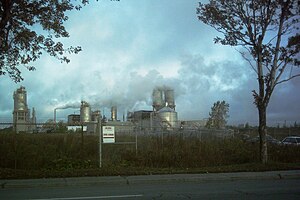Montréal-Est
| Montréal-Est | ||
|---|---|---|
 Industrial zone in Montréal-Est |
||
| Location in Quebec | ||
|
|
||
| State : |
|
|
| Province : | Quebec | |
| Administrative region : | Montreal | |
| Coordinates : | 45 ° 37 ′ N , 73 ° 31 ′ W | |
| Height : | 19 m | |
| Area : | 12.45 km² | |
| Residents : | 3728 (as of 2011) | |
| Population density : | 299.4 inhabitants / km² | |
| Time zone : | Eastern Time ( UTC − 5 ) | |
| Municipality number: | 66007 | |
| Postal code : | H1B | |
| Area code : | +1 514 | |
| Mayor : | Robert Coutu | |
| Website : | www.ville.montreal-est.qc.ca | |
 Location of Montréal-Est in the Montreal agglomeration |
||
Montréal-Est is a city in the southwest of the Canadian province of Québec . It is located on the Île de Montréal and forms an enclave within Montreal . The city has an area of 12.45 km² and has a population of 3,728 (2011).
geography
Montréal-Est is located in the north of the Île de Montréal, on the banks of the Saint Lawrence River . The community is surrounded on three sides by the Montreal urban area and borders the districts of Rivière-des-Prairies-Pointe-aux-Trembles in the north, Anjou in the southwest and Mercier-Hochelaga-Maisonneuve in the south. Montreal city center is around 16 kilometers away.
history
Montréal-Est was created in 1910 when the municipalities of Pointe-aux-Trembles and Saint-Joseph-de-la-Rivière-des-Prairies gave up territory. The foundation goes back to the businessman Joseph Versailles. In 1915, Queen's Oil opened the first oil refinery . Even today, three refineries and five petrochemical companies shape the community.
On January 1, 2002, 27 parishes on the island were merged with Montreal. Resistance arose especially in communities with a high proportion of English speakers, as this measure had been ordered by the provincial government of the separatist Parti Québécois . From 2003, the Parti libéral du Québec provided the government and promised to reverse the merger of the municipalities. On July 20, 2004, referendums were held in 22 former municipalities. In Montréal-Est, 84.5% of voters were in favor of the separation. The community was re-established on January 1, 2006, but had to cede numerous competencies to the community association.
population
According to the 2011 census, Montréal-Est had 3,728 inhabitants, which corresponds to a population density of 299.4 inh / km². 88.4% of the population stated French as their main language, while English accounted for 3.5%. 0.8% said they were bilingual (French and English), 7.3% other languages and multiple answers (including 2.5% Spanish ). Only French were spoken by 63.5%. In 2001, 90.0% of the population were Roman Catholic , 2.6% Protestant and 4.7% non-denominational.
traffic
The main arteries of Montréal-Est run in a south-north direction. These are Autoroute 40 , Rue Sherbrooke and Rue Notre-Dame . The city is accessed by several bus lines from the Société de transport de Montréal and connected to the Honoré-Beaugrand metro station.
Web links
Individual evidence
- ↑ Montréal-Est. Commission de toponymie Québec, accessed August 16, 2011 (French).
- ↑ Référendums du 20 juin 2004. Directeur général des élections du Québec, accessed on August 17, 2011 (French).
- ↑ Population profile of the municipality of Montréal-Est. In: 2011 Census. Statistics Canada , 2011, accessed January 7, 2014 (French).
- ↑ Population profile of the municipality of Montréal-Est. In: 2001 Census. Statistics Canada , 2001, accessed January 7, 2014 (French).
